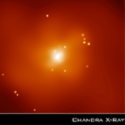Trouble for dark matter explanations of excess cosmic positrons
Recent reports of an apparent excess of high-energy positrons in cosmic rays have received much interest in the particle physics and astrophysics communities, largely because of the possibility that the excess may result from the annihilation of dark matter particles. However, the annihilation cross section inferred from the relic density of dark matter appears to be too small by two to three orders of magnitude to explain the excess. It has been pointed out that if the dark matter particles interact with a light force-carrying boson, there can be, as a result, an enhancement of annihilation at the lower velocities characteristic of dark matter today . Therefore, it was suggested that the relatively smaller cross section needed to account for the relic density could possibly be reconciled with the larger annihilation rates needed to explain the positron excess.
In a paper appearing in Physical Review Letters, Jonathan L. Feng, Manoj Kaplinghat, and Hai-Bo Yu of the University of California, Irvine, in the US point out problems with this explanation: The enhancement is proportional to the coupling of dark matter to the force carrier, and if the coupling is large enough to give the needed enhancement, then it is too large to be consistent with the relic density, so the desired reconciliation cannot be achieved. Moreover, for very light force carriers, self-interactions of the dark matter in models of this type lead to spherical galactic halos of dark matter, inconsistent with observations of elliptical halos. Unless a way around these problems can be found, this approach to explaining the positron excess seems ruled out. – Stanley Brown
[1] Nima Arkani-Hamed, Douglas P. Finkbeiner, Tracy R. Slatyer, and Neal Weiner, Phys. Rev. D 79, 015014 (2009); see also http://physics.aps.org/synopsis-for/10.1103/PhysRevD.79.015014
[2] M. Cirelli, M. Kadastik, M. Raidal, and A. Strumia, Nucl. Phys. B 813,1 (2009).





